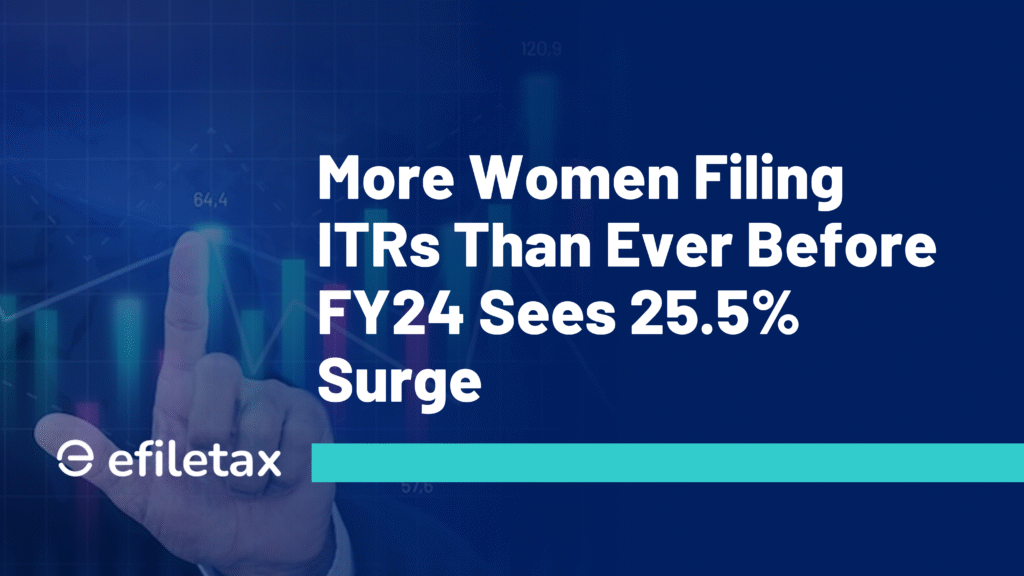
Summary
In FY 2023–24, over 25.5% of all ITRs were filed by women, marking a steady rise in female tax participation. This blog decodes what this means for Indian taxation, women’s financial independence, and future policy changes.
Rise in Women Income Tax Filers: FY24 Trends
The focus keyphrase “women income tax filers” is making headlines this year — with 25.5% of all ITRs in FY24 filed by women, as per recent CBDT data shared with the Ministry of Finance. This is a notable increase from earlier years and signals a shift in financial inclusion and gender participation in India’s formal economy.
Let’s break this down in simple terms.
What Does This Spike Really Mean?
Here’s why the rise in women income tax filers matters:
- Increased workforce participation post-COVID
- Greater digital access and simplified tax filing (thanks to portals like Efiletax!)
- Government initiatives like:
- Startup India & Stand Up India (for women entrepreneurs)
- PMMY – MUDRA loans (for self-employed women)
- Growing financial literacy among women, especially in Tier 2 & 3 cities
Year-Wise Trend of Women ITR Filers
| Financial Year | Women ITR Filers (%) |
|---|---|
| 2019–20 | ~22.3% |
| 2020–21 | ~23.1% |
| 2021–22 | ~24.2% |
| 2022–23 | 24.7% |
| 2023–24 | 25.5% |
Source: Income Tax Department updates, MoF data shared in PIB
Tax Benefits Available to Women
Even though India’s income tax slabs are gender-neutral, women can still save smartly through these routes:
Common Deductions for Women
- Section 80C – Up to ₹1.5 lakh (LIC, PPF, ELSS)
- Section 80D – Medical insurance for self & family
- Section 24(b) – Interest on housing loan (₹2 lakh max)
- Section 80E – Interest on education loan
- Section 87A – Rebate up to ₹25,000 for incomes under ₹7 lakh under new regime
Special Tip (Expert View)
“Women should consider opening a PPF account or investing in Sukanya Samriddhi Yojana (SSY) if they have a girl child. These not only save tax but promote disciplined saving.”
— Tax Consultant at Efiletax
Government Push for Financial Equality
Here’s how the Indian government is encouraging more women to file ITRs:
- Mahila Samman Savings Certificate (Budget 2023):
- 7.5% interest
- ₹2 lakh max limit
- Taxable, but helps build corpus
- Digital India push: Simplified e-filing through mobile-friendly portals like incometax.gov.in and platforms like Efiletax
- Women-led SHGs and micro-entrepreneurship are being tracked under Udyam portal registrations, encouraging formal compliance
How to File ITR Easily (Step-by-Step for Women First-Timers)
- Register on the Income Tax Portal
- Link PAN with Aadhaar (mandatory)
- Choose the correct ITR form (e.g., ITR-1 for salaried individuals)
- Opt between new and old tax regime
- Upload documents (Form 16, interest certificates)
- File and e-verify via Aadhaar OTP or netbanking
👉 Need help? Efiletax can guide you
FAQs on Women Income Tax Filers
Q1. Are women eligible for extra tax benefits in India?
No separate slabs, but deductions under 80C, 80D, and 24(b) apply equally.
Q2. Can homemakers file ITR?
Yes, if they earn income from rent, freelance work, or interest.
Q3. What ITR form is used by salaried women?
Generally, ITR-1. But ITR-2 or ITR-3 may apply for capital gains or business income.
Final Thoughts
The steady increase in women income tax filers is a positive sign for India’s economy and gender equity. At Efiletax, we believe more women filing returns = more empowered households.
✅ Want to start filing your ITR with expert help?
Visit 👉 Efiletax.in — trusted by professionals, women entrepreneurs, and salaried individuals across India.